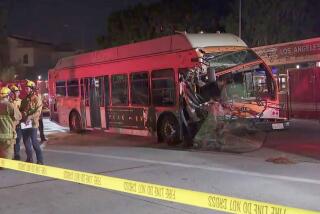Faulty Wheels Suspected in Derailment
- Share via
The derailment of a Los Angeles-bound freight train that crashed into a Mt. Washington apartment building may have been caused by faulty wheels on a boxcar, state officials said Tuesday.
Investigators determined that the derailment occurred when a section of track bent under the weight of a passing freight car, said Ed Damrom of the Public Utilities Commission’s Railroad Operations and Safety Section.
Damrom said investigators were trying to determine why the rail, which was in good condition before the accident, bent and triggered the derailment. He said the most plausible theory was that the wheels, or “trucks,” of one boxcar may have been defective and caused the boxcar’s load to shift while the car negotiated a curve.
Eight families were temporarily left homeless by the Monday morning derailment. After Santa Fe Railroad crews removed the demolished boxcars, city officials allowed residents to return to all but two units in the 11-unit apartment building Tuesday afternoon.
Meanwhile, workers laid 2,500 feet of new track to replace that damaged in the accident. The rail line, which serves freight and passenger traffic, was expected to be reopened by early today after several hours of testing, said Dave Mansheim, assistant superintendent with the railroad. Residents of the damaged apartment building in the 4600 block of North Figueroa Street were not pleased to hear news of the rail line’s reopening. Some said that the accident--which crushed several cars in the apartment building’s parking lot--had left them traumatized.
Rocio Peralta, 20, said that after the accident she spent a restless night tossing and turning on a cot at a nearby Red Cross evacuation shelter. Her apartment was one of those most seriously damaged by the derailment.
She fell asleep just long enough to have a brief nightmare in which she struggled to save her 2 1/2-year-old son, Enrique, from crashing boxcars.
“I could feel the train, I could see the train coming,” Peralta said in Spanish. “I reached for my son, to save him. And then my husband woke me up.”
Enrique, she said, would wave to the passing trains each morning while standing on the apartment steps, which were crushed in the accident.
On the day of the derailment, Peralta said, Enrique slept late because a neighbor’s party had kept the family awake all night.
“It’s a miracle that my son wasn’t there,” she said.
Investigators determined Tuesday that the derailment occurred after a rail bent and “flipped over” under the weight of a boxcar carrying two metal containers, one stacked on top of the other.
“Double stacking” is common on freight cars but, in Monday’s accident, the load may have become unevenly distributed because of a faulty suspension system in the wheelbase, Damrom said. This would have caused the boxcar to bend the rail as it negotiated the curve.
After the rail curved, the double-stacked boxcar rode for several hundred feet along the inner edge of the track. It was the first car in the 53-car train to derail, Damrom said. Eleven other cars also left the tracks.
Damrom added that Santa Fe officials inspect the track three times a week. It had last been inspected Friday and was in good condition, he said.
Investigators said they determined that the train was traveling 18 m.p.h. at the time of the accident, below the 25 m.p.h. speed limit established for freight trains on the curving track.
More to Read
Sign up for Essential California
The most important California stories and recommendations in your inbox every morning.
You may occasionally receive promotional content from the Los Angeles Times.











